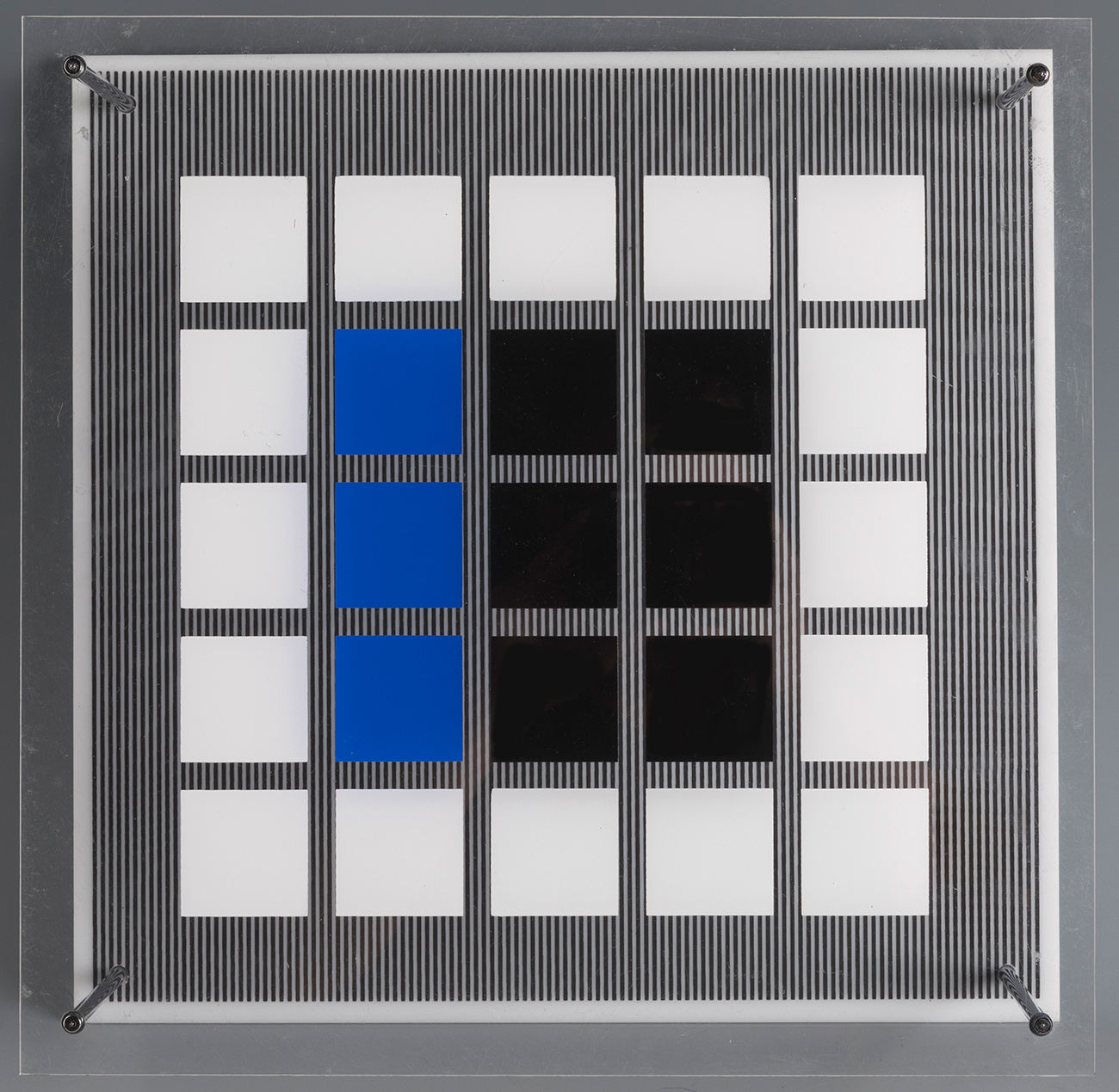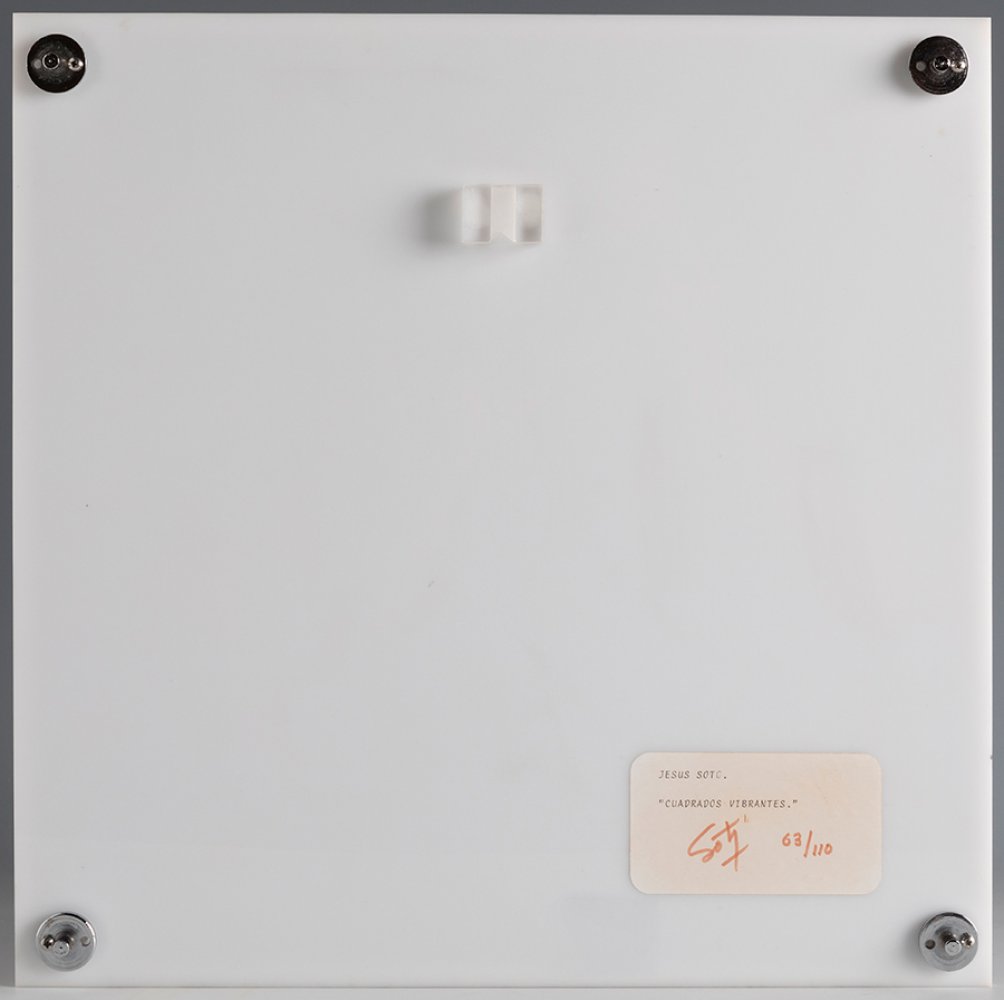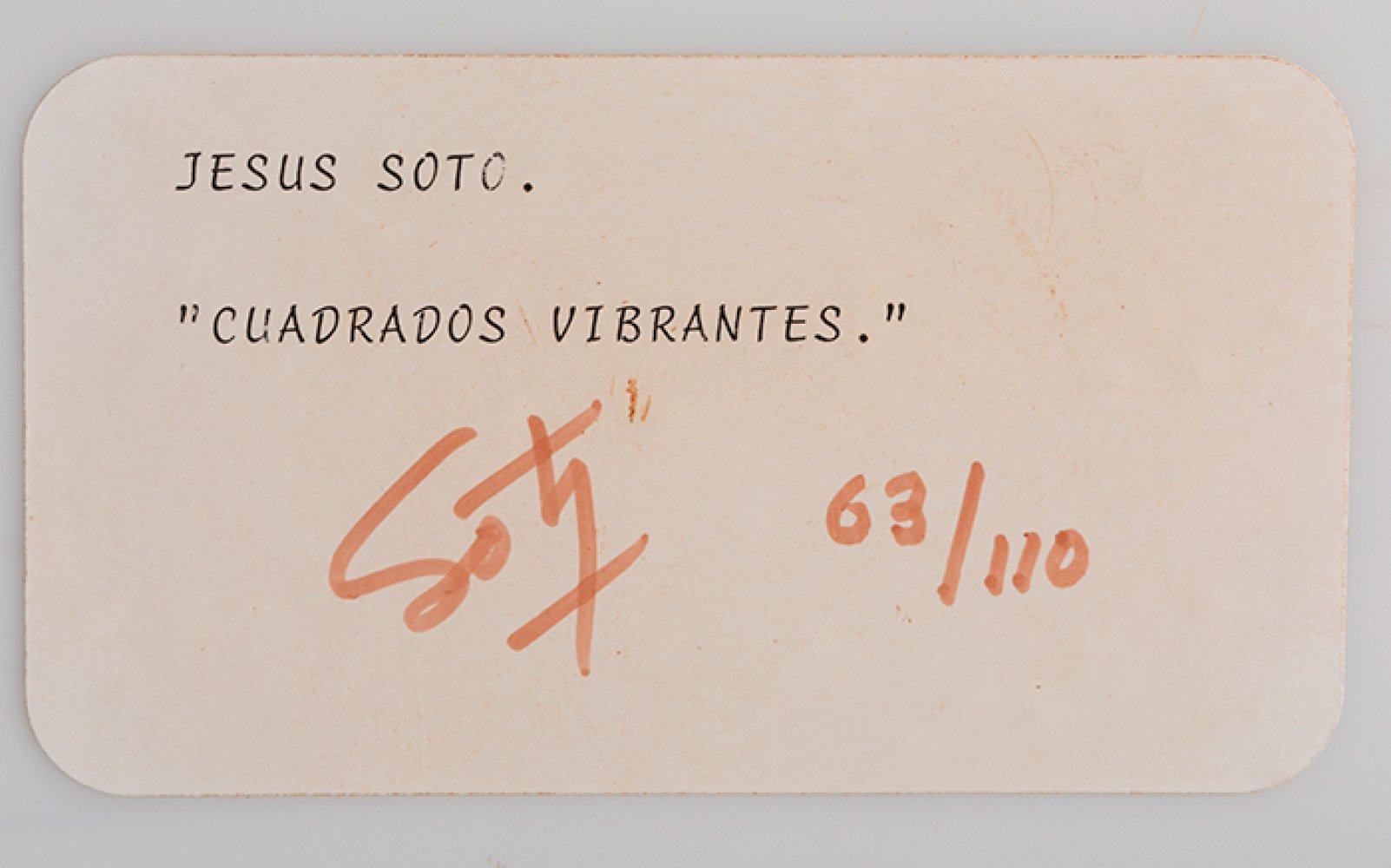58
JESÚS RAFAEL SOTO (Ciudad Bolívar, Venezuela, 1923 - Paris, 2005)."Vibrant squares". Síntesis"
JESÚS RAFAEL SOTO (Ciudad Bolívar, Venezuela, 1923 - Paris, 2005).
"Vibrant squares". Síntesis" series, 1979.
Silkscreen on plexiglass and metal structure. Copy 63/110.
Published by the Banco Central de Venezuela, Caracas.
Signed and numbered by the artist on a label affixed to the reverse.
Publications: "La Universidad de lo Inmaterial: Soto", exhibition catalogue of the Museo de Arte Latinoamericano, pg. 62 Soto, Ministry of Culture, p.68, 129.
Size: 39 x 39 x 14 cm.
Rafael Soto's "Vibrant Paintings" are to be understood as part of the artist's vital research into the theories of colour, geometry and negative space, together with the use of synthetic materials, achieving vibrant and dynamic effects. The Venezuelan artist had been a pioneer of Op Art in Latin America, developing his avant-garde research since the 1940s, with which he sought to construct shared experiences, a sharing of experiences between spectators and creators. This is evident in the experimental works united under the heading "Síntesis" (Synthesis).
Soto began his serious artistic career when he started creating and painting posters for cinemas in Ciudad Bolívar. After painting posters, he received a scholarship to study art training at the Escuela de Artes Plásticas y Artes Aplicadas in Caracas from 1942 to 1947. Once there, he took classes in "pure art" and the "training course for instructors in the history of art education". After graduating from the Escuela de Artes Plásticas y Artes Aplicadas, he received a teaching degree, then was hired to be director of the Escuela de Bellas Artes in Maracaibo from 1947 to 1950. While teaching there, he received a government scholarship. To travel to France, he settled in Paris. When Soto arrived in Europe in 1951, geometric abstraction was not very popular. He proposed a new type of movement that would add to three-dimensional art. In 1954, he began associating with Yaacov Agam, Jean Tinguely, Victor Vasarely and other artists associated with the Salon des Réalités Nouvelles and the Galerie Denise René. Soto was an innovator and created a new medium for geometric works. Essential to these "optical illusions" was plexiglass. Soto did not feel constrained by the size of his works. His works ranged from the smallest scale such as Kinetic Structures of Geometric Elements (1955) to the human scale of Cube à espace ambigu (1969). During his "baroque" period, Soto expressed his ideas and visions in haptics, creating works such as Puntos de goma (Rubber Dots, 1961) and Borroco nergro (Baroque in Black, 1961.) During this time, Soto also worked on his Penetrables, which were metal and plastic works that the viewer could interact with by walking through them. Soto participated in Le Movement in 1955, which is one of the major exhibitions that helped launch his career in kinetic art. Years after his stay in Paris, Soto's art shifted between organic and geometric forms. Soto's most important works of the 1950s and 1960s were abstracts painted in geometric forms that used a carefully selected palette of colours.
JESÚS RAFAEL SOTO (Ciudad Bolívar, Venezuela, 1923 - Paris, 2005).
"Vibrant squares". Síntesis" series, 1979.
Silkscreen on plexiglass and metal structure. Copy 63/110.
Published by the Banco Central de Venezuela, Caracas.
Signed and numbered by the artist on a label affixed to the reverse.
Publications: "La Universidad de lo Inmaterial: Soto", exhibition catalogue of the Museo de Arte Latinoamericano, pg. 62 Soto, Ministry of Culture, p.68, 129.
Size: 39 x 39 x 14 cm.
Rafael Soto's "Vibrant Paintings" are to be understood as part of the artist's vital research into the theories of colour, geometry and negative space, together with the use of synthetic materials, achieving vibrant and dynamic effects. The Venezuelan artist had been a pioneer of Op Art in Latin America, developing his avant-garde research since the 1940s, with which he sought to construct shared experiences, a sharing of experiences between spectators and creators. This is evident in the experimental works united under the heading "Síntesis" (Synthesis).
Soto began his serious artistic career when he started creating and painting posters for cinemas in Ciudad Bolívar. After painting posters, he received a scholarship to study art training at the Escuela de Artes Plásticas y Artes Aplicadas in Caracas from 1942 to 1947. Once there, he took classes in "pure art" and the "training course for instructors in the history of art education". After graduating from the Escuela de Artes Plásticas y Artes Aplicadas, he received a teaching degree, then was hired to be director of the Escuela de Bellas Artes in Maracaibo from 1947 to 1950. While teaching there, he received a government scholarship. To travel to France, he settled in Paris. When Soto arrived in Europe in 1951, geometric abstraction was not very popular. He proposed a new type of movement that would add to three-dimensional art. In 1954, he began associating with Yaacov Agam, Jean Tinguely, Victor Vasarely and other artists associated with the Salon des Réalités Nouvelles and the Galerie Denise René. Soto was an innovator and created a new medium for geometric works. Essential to these "optical illusions" was plexiglass. Soto did not feel constrained by the size of his works. His works ranged from the smallest scale such as Kinetic Structures of Geometric Elements (1955) to the human scale of Cube à espace ambigu (1969). During his "baroque" period, Soto expressed his ideas and visions in haptics, creating works such as Puntos de goma (Rubber Dots, 1961) and Borroco nergro (Baroque in Black, 1961.) During this time, Soto also worked on his Penetrables, which were metal and plastic works that the viewer could interact with by walking through them. Soto participated in Le Movement in 1955, which is one of the major exhibitions that helped launch his career in kinetic art. Years after his stay in Paris, Soto's art shifted between organic and geometric forms. Soto's most important works of the 1950s and 1960s were abstracts painted in geometric forms that used a carefully selected palette of colours.
15th November - Contemporary & Acual Art
Sale Date(s)
Venue Address
General delivery information available from the auctioneer
Setdart offers Worldwide shipping
PICK UP IN ROOM: You can come and pick up your lots in our offices (Barcelona, Madrid or Valencia). At the moment of the withdrawal, you will be able to accept the current conditions of the lot by means of a document that you will sign.
YOU CAN SEND ANOTHER PERSON TO PICK UP: This person must present a signed authorization that you can find in our web page by accessing from BUY AT SETDART- LOGISTICS-DOWNLOAD AUTHORIZATION DOCUMENT. You can also send an e-mail with the requested data in AUTHORIZATION DOCUMENT to admin@setdart.com
Important Information
25% buyer´s premium
OR
21% buyer´s premium at www.setdart.com
Terms & Conditions
The maximum period to pay the lots is 7 working days. You can pay either via bank transfer or with credit card through our platform www.setdart.com (we only accept VISA or Mastercard).
BUYER´S PREMIUM: 22% Hammer price + 21% VAT from the buyer´s premium
If your piece has more than 100 years, our Ministry of Culture requires an export certificate in order for the piece to leave the country. Note that if the piece goes inside the EU, there is no cost for the export certificate. If the piece goes outside the EU, there is a cost for the export certificate. You can find more information in our Ministry of Culture website: https://www.culturaydeporte.gob.es/en/cultura/patrimonio/exportacionimportacion/exportacion/tasas.html
INQUIRIES: admin@setdart.com
Setdart guides you through the entire process, from the time of award to the day you receive your lot. Our logistics team will be happy to manage your transport, and will advise you on the best shipping method with professionals from the sector used to handling works of art and jewelry.
WE OFFER WORLDWIDE DOOR TO DOOR SHIPPING
PICK UP IN ROOM: You can come and pick up your lots in our offices. At the moment of the withdrawal, you will be able to accept the current conditions of the lot by means of a document that you will sign.
YOU CAN SEND ANOTHER PERSON TO PICK UP: This person must present a signed authorization that you can find in our web page by accessing from BUY AT SETDART-LOGISTICS-DOWNLOAD AUTHORIZATION DOCUMENT. You can also send an e-mail with the requested data in AUTHORIZATION DOCUMENT to admin@setdart.com
SETDART IS NOT RESPONSIBLE FOR THE STATE OF THE PARTS ONCE THEY LEAVE OUR FACILITIES. MRW SHIPMENTS: Once the payment is made, your lot will be packed for shipment, the logistics department will send you an e-mail notifying you of the day it leaves our warehouse, changes of address cannot be made after receiving this e-mail.
INSURANCE INCIDENTS: Coverage for the value of the auction up to 3000 ? per shipment, if the value of the auction is higher, Setdart will send you a quote including the additional insurance. The insurance company WILL NOT BE RESPONSIBLE FOR THE SHIPMENT THAT EXCEEDS THAT AMOUNT AND IS NOT FULLY INSURED. MRW INCIDENTS: Maximum notification 48 hours after receipt, after which the insurance company WILL NOT BE RESPONSIBLE AND NO CLAIMS WILL BE ACCEPTED.
E-MAIL LOGISTICS: logistica@setdart.com
PICK UP YOUR MESSAGES: You can send your own messaging, prior notice via e-mail that your shipment is ready, please note 3 or 4 days in advance. This type of shipment is packaged so Setdart will provide you with a quote.
EXPENSES FOR STORAGE: We inform you that if the purchased lot is not picked up within a month, you will be charged 30€ per week per lot. Setdart Online S.L., owner of the web site "setdart.com", "setdart.net" and "setdart.org", acts as a company of Spanish nationality inscribed in the Volume 36955, sheet 182, page B-293056 of the Mercantile Registry, with registered office at Calle Aragó















